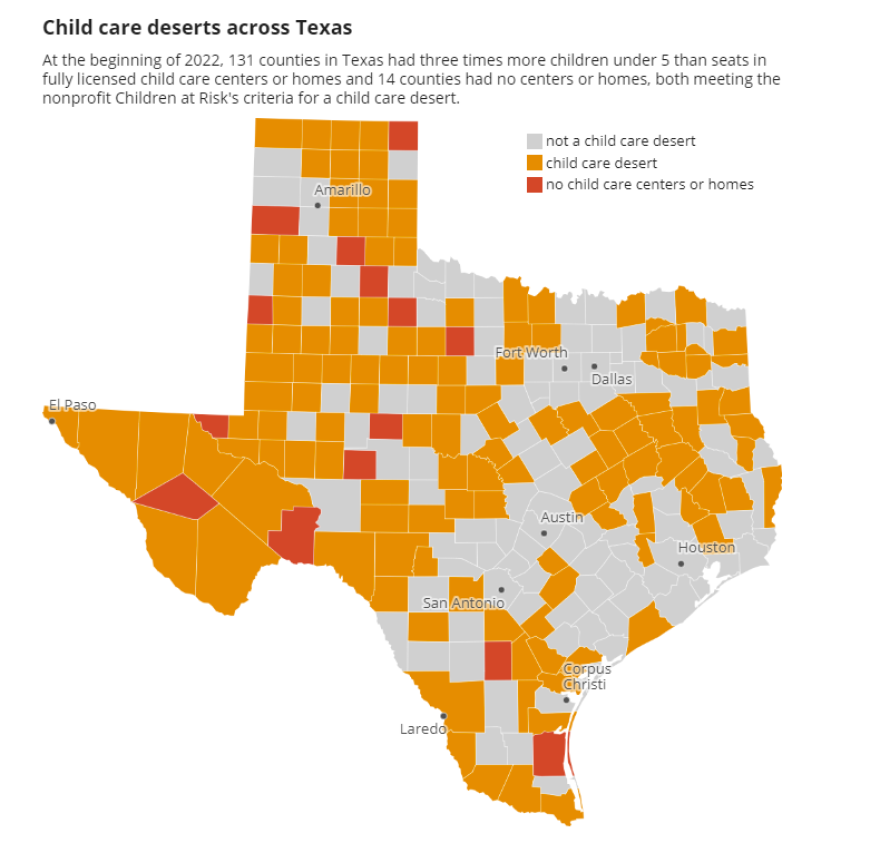As the COVID-19 pandemic surged through the United States in early 2020, Phyllis Montoya watched the children leave her Pflugerville home-based day care facility one by one.
“The kids left,” Montoya said. “Either parents were worried or parents were changing [working] conditions where they could be home. … A lot of people were scared.”
Montoya, who has run Kid's Castle Family Daycare and Preschool in the Austin suburb for 15 years, said it has a capacity of 12 kids, but even after parents started coming back to her seeking child care, she’s kept her head count to half of what it was before the pandemic.
“I could fill up, but I feel like I have a responsibility to the parents, especially during the deepest part of [the pandemic] where we were so terrified, to keep my babies safe,” Montoya said. “So in order to do that, I had to have really a lot of trust with my parents that we were both going to stay within guidelines.”

In April 2020, after Gov. Greg Abbott issued a stay-at-home order in response to the pandemic, more than a quarter of licensed child care operations in Texas temporarily closed.
Although Abbott lifted the order for all child care services about a month later, more service providers continued to close temporarily, with the number of operations providing care reaching a pandemic low in May 2020.
Since then, the providers that have survived the tumult of the past two years have mostly reopened. Here is a look at how COVID-19 has impacted child care in Texas and how the state was faring as of January, when the latest Health and Human Services numbers were made available.
Throughout 2019 and into the beginning of 2020, about 95% of licensed child care operations in the state were open and providing care. In May 2020, less than two-thirds were open — about 10,500 operations statewide.
Child care providers resumed care in subsequent months, but some temporary closures became permanent. As of January, the number of licensed operations has declined by about 8% from May 2020. So although about 97% of operations are open again, there are fewer licensed child care providers now than before the pandemic.

Montoya closed her day care temporarily for two weeks at the beginning of the pandemic. Once she reopened, she said she experienced a “roller coaster” in trying to keep her business afloat. At times, she said, she was caring for only two or three children.
“I can see why a lot of day care providers are closing because they just can't pay the bills,” Montoya said. “And I know this is the most challenging financially it's been for me in the whole history of me being a child care provider. It's just the burden and the stress and fear of losing even one more child that could push me over the edge to where I can’t stay open.”
The number of home-based child care businesses like Montoya's has declined by about 15% since January 2020. Child care homes, which currently provide about 5% of available child care slots in the state, are based in the provider’s home and are permitted to care for between three and 12 children. Child care centers, which provide the other 95% of available slots, can offer care for more than 13 children at a location other than the provider’s home.

The shortage of day care openings forced many parents to search for alternatives such as nannying or babysitting services. Michelle LaRowe, executive director of nanny referral agency Morningside Nannies in Houston, said that during the peak of the omicron surge in January, she saw a record number of parents looking for a nanny and a record shortage of nannies.
“I can't believe the number of calls we get every day for families looking for care and desperate for care and have looked on their own and haven't found anything,” LaRowe said. “Because when [day cares] close down for [a COVID-19] exposure, it's really been a challenge for working families.”
LaRowe said in 25 years of working in child care, she’s never seen such a disparity between families seeking nannies and nannies seeking jobs. As her inquiries for nannies doubled, she said applications from people seeking nanny jobs with her agency decreased by three-quarters between November and late January.
Because working in someone’s home can bring a risk of COVID-19 exposure — and because many parents don’t know how long they’ll need child care help as employers and schools change COVID policies — many nannies have opted for gig economy jobs like driving for Uber, she said.

Pandemic closures have impacted providers across the child care industry — not only those caring for children under 5. Before- and after-school programs were hit harder by closures than any other type of child care operation. From May to August 2020, all but roughly 10% of these programs closed temporarily.
Although before- and after-school programs started to reopen at the beginning of the 2020-21 school year, 16% of them remained closed at the end of the school year. As of January, virtually all licensed programs have reopened, but Texas has nearly 100 fewer programs than it did before the pandemic.

For some areas, the impacts have lasted longer and been felt more profoundly — especially in so-called child care deserts, where there are three times more children under 5 than licensed slots in child care operations — as defined by Children at Risk, a nonpartisan, nonprofit research organization based in Texas.
Before the pandemic, between child care centers and home day cares in the state, there were more than 1.1 million licensed slots for about 2 million children under 5. In January 2020, 150 of the state’s 254 counties — 59% — met the criteria for being a child care desert. Of those, 138 had at least three times more children under 5 than licensed seats in open operations and 12 had no operations at all.
By May 2020, about a half of all centers and a fifth of all homes had temporarily closed as the pandemic took hold, leaving less than 660,000 slots available.
By the beginning of this year, the number of slots had returned close to pre-pandemic levels, with 145 counties meeting the criteria for being a child care desert.

Texas has received billions in federal aid for child care providers since the beginning of the pandemic, starting with $371 million from the Coronavirus Aid, Relief, and Economic Security (CARES) Act passed in March 2020.

Since then, the federal government allocated an additional $1.1 billion to Texas child care providers through the 2021 Coronavirus Response and Relief Supplemental Appropriations Act, which was signed into law in December 2020. About half of that $1.1 billion has already been sent to 9,456 Texas child care providers and is set to be fully distributed by this fall, said Angela Woellner, a Texas Workforce Commission spokesperson.
Texas will distribute another $2.45 billion to child care providers through the federal American Rescue Plan Act of 2021, which went into effect last March. In February, The Workforce Commission approved giving an additional billion dollars of federal money to the state’s child care providers, Woellner said.
Eligible child care operations must be licensed or registered with the state as of Feb. 28 and either actively offering child care services when they submit an application or have plans to reopen within 30 days if they closed temporarily due to a COVID-19-related hardship.
Woellner said the commission plans to send application invitations to about 12,000 eligible child care providers by the end of the month; the application deadline is May 31. The commission plans to approve applications and begin sending money to applicants within a week and will distribute the money over the next year, she said.
The Texas Tribune is a nonpartisan, nonprofit media organization that informs Texans — and engages with them – about public policy, politics, government and statewide issues.
Copyright 2022 Texas Public Radio. To see more, visit Texas Public Radio.








